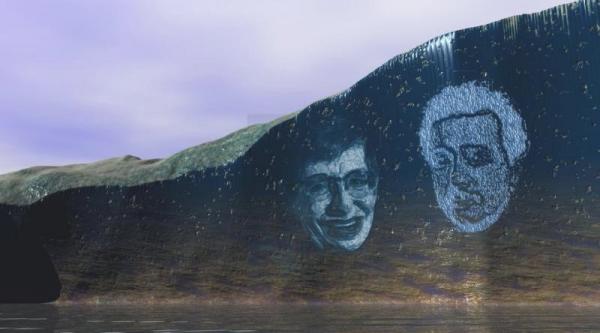BY LETTER
Heritage Range, The
Famous range of mountains on Corona | |
 Image from Loopquanta | |
| The Heritage Range of mountains, showing the carvings of Hawking and Einstein | |
The mountains of the Heritage Range rise sharply out of the lowlands around Feynman Bay on Corona, and present a series of steep faces looking out over the waters. Beginning in 4874, the Superior artist Lebodon Banx set about carving the likenesses of the great scientific minds of terragens history (up to that point) into the face of the mountain range.
Working alone and with minimal robotic assistance, it took Banx some three hundred years to complete eir great work. Where sheer rocky mountain slopes had once stood there was now a long line of faces, each 100m tall, carved into the rock. Beginning with such notable ancient figures as Archimedes and Galileo and continuing on through various faces both famous (Einstein, Hawking, Duorkin) and almost unknown (Enduring Blue of the Summer Light), Banx's masterpiece gained em instant celebrity and not a few followers. At the same time e also became the target of a number of naturalist, Bioist, and Caretaker leaning factions who objected to the 'spoiling' of the natural beauty of the original mountains. Even at the time this was largely seen as something of an empty argument given that Corona itself was the product of 'unnatural' processes having been terraformed. The protesters never really gained any significant following and largely fell into silence and obscurity in short order.
In the modern era, the Heritage Range is seen as a proud symbol of Coronian scientific prowess and history. Most tourists to the Corona system make it a point to visit the range and it is a favorite backdrop for concerts, sporting events, and similar occasions. In 5310 a microlayer of nanodiamond was laid down over each face and stabilizing carbon nanoweave was injected into the mountain's underlying substructure to protect it against the ravages of time in the form of weather and geologic shift.
Related Articles
Appears in Topics
Development Notes
Text by Todd Drashner
Initially published on 16 May 2007.
Initially published on 16 May 2007.






